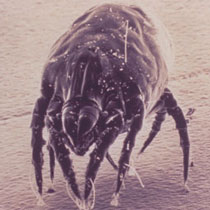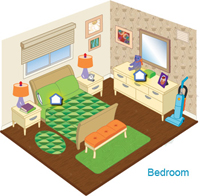Dust mites are microscopic animals that can trigger allergic reactions in susceptible people. Dust mites are one of the most common causes of indoor allergies.

Dust mites thrive in warm, humid environments where they feed on the dried scales of human skin. This means that they are found most commonly found in bedding, stuffed furniture, carpets, old clothing, and stuffed toys. Dust mites cannot survive in climates where the humidity is below 50%, so they are not a common problem for those living in arid areas, such as Arizona or Southern California.
It is the droppings and decaying bodies of the dust mites that trigger allergies. If the droppings of dust mites are inhaled or come in contact with the skin, a susceptible person may experience allergic rhinitis, asthma and/or itching skin due to eczema.
Dust mite residue can becomes airborne when it mixes with dust. You won't notice it if you aren't allergic to dust mite residue. But if you are, the residue can cause uncomfortable symptoms, including wheezing, sneezing, watery eyes and runny nose.
The best treatment for dust mite allergy is avoidance—that is, taking measures to reduce the number of dust mites in your home. Your doctor may also recommend allergy medications or allergy injections.

What are the symptoms of dust mite allergy?
Symptoms of dust mite allergy are similar to those of hay fever (allergic rhinitis), and they include:
- Itch. Itchy nose and/or itchy, watery eyes.
- Runny nose and nasal congestion, possibly with post-nasal drip
- Sneezing and coughing
- If asthmatic, a worsening of asthma symptoms, including wheezing and shortness of breath.
If you are prone to nocturnal asthma (asthma attacks at night), sleeping in a bed infested with dust mites may trigger an asthma attack.
A mild dust mite allergy may result in an occasional runny nose, watery eyes and sneezing. In severe cases, the condition is chronic—resulting in such symptoms as persistent wheezing, sneezing, congestion and facial pressure.
How is dust mite allergy treated?
Eliminate allergens from your environment
The best way to prevent an allergic reaction to dust mites is to eliminate these allergens from your environment. By minimizing your exposure to dust mites, you'll also minimize the symptoms of an allergic reaction—such as watery eyes, runny nose and sneezing. Adopting rigorous cleaning practices, especially in the bedroom, can reduce dust mite residue to a level where it no longer causes bothersome problems.
Medications
When you can't control your allergic reactions to dust mites with prevention measures, your doctor may recommend allergy medications. Such medications include over-the-counter or prescription antihistamines, decongestants, cromolyn sodium nasal sprays, prescription corticosteroid nasal sprays or inhalants, or bronchodilators (which help open up the airways in the lungs).
Immunotherapy
For especially difficult symptoms, your doctor may recommend allergy shots (immunotherapy) to desensitize you to dust mites.
In this treatment, you'll receive injections of dust mite extract in increasing doses once or twice a week. After a maintenance dose has been reached, you'll need injections every four weeks.
What steps can I take to control dust mite allergens?
- Enclose your mattress and boxsprings in a zippered dust-proof encasing, which will keep the dustmites inside the casing and away from you. For best results, place cloth tape over the encasing zipper.
- Wash all bedding in hot (130° F) water, weekly.
- Put pillows in zippered dust proof encasings and/or wash the pillows every week with your bedding.
- Don't lie on upholstered furniture or carpet.
- If you have carpet in your bedroom, consider removing it and replacing it with washable area rugs.
- Use wood, leather or vinyl furniture instead of upholstered furniture in the bedroom.
- Make sure rugs and carpets are vacuumed frequently. The person with a dust mite allergy should not vacuum or be in a room while it is being vacuumed.
- Keep the indoor moisture low, ideally at the 30-40% level. In warm climates, an air conditioner or dehumidifier will keep humidity low.
- Try not to use humidifiers and vaporizers, because they create a friendly environment for dust mites. If you must use a humidifier, clean it daily to prevent mold growth.
- Chemical solutions may be helpful. Acaricides is a chemical that kills dust mites and can be applied regularly to carpeting or upholstered furniture, although it won't remove existing mite droppings. A tannic acid solution, applied as directed, can help neutralize the allergen in mite droppings.
Source: Vivacare
Last updated : 5/2/2020